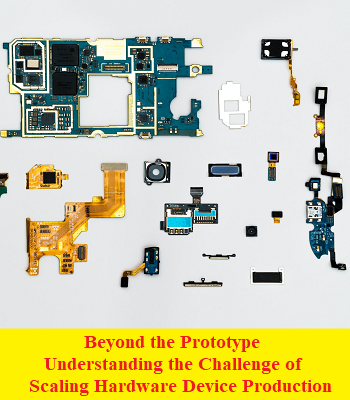Admin
مدير المنتدى


عدد المساهمات : 18992
التقييم : 35482
تاريخ التسجيل : 01/07/2009
الدولة : مصر
العمل : مدير منتدى هندسة الإنتاج والتصميم الميكانيكى
 |  موضوع: بحث بعنوان Beyond the Prototype : Understanding the Challenge of Scaling Hardware Device Production موضوع: بحث بعنوان Beyond the Prototype : Understanding the Challenge of Scaling Hardware Device Production  السبت 29 أكتوبر 2022, 4:01 am السبت 29 أكتوبر 2022, 4:01 am | |
| 
أخواني في الله
أحضرت لكم
بحث بعنوان
Beyond the Prototype: Understanding the Challenge of Scaling Hardware Device Production
Rushil Khurana
Carnegie Mellon University,
Pittsburgh, PA, USA
rushil@cmu.edu
Steve Hodges
Microsoft Research
Cambridge, UK
steve.hodges@microsoft.com

و المحتوى كما يلي :
ABSTRACT
The hardware research and development communities have
invested heavily in tools and materials that facilitate the
design and prototyping of electronic devices. Numerous
easy-to-access and easy-to-use tools have streamlined the
prototyping of interactive and embedded devices for experts
and led to a remarkable growth in non-expert builders.
However, there has been little exploration of challenges
associated with moving beyond a prototype and creating
hundreds or thousands of exact replicas – a process that is
still challenging for many. We interviewed 25 individuals
with experience taking prototype hardware devices into low
volume production. We systematically investigated the
common issues faced and mitigation strategies adopted. We
present our findings in four main categories: (1) gaps in
technical knowledge; (2) gaps in non-technical knowledge;
(3) minimum viable rigor in manufacturing preparation; and
(4) building relationships and a professional network. Our
study unearthed several opportunities for new tools and
processes to support the transition beyond a working
prototype to cost effective low-volume manufacturing.
These would complement the aforementioned tools and
materials that support design and prototyping.
Author Keywords
Hardware device realization; low volume electronics manufacturing; productization; long tail hardware.
CONCLUSION & FUTURE WORK
We started the research reported in this paper knowing that
in the past decade it has become much easier to design and
build a prototype of a hardware device. This is due to the
proliferation of research, commercial products and online
communities which support Phase 1. But scaling from a
prototype to the production of hundreds or thousands of units
is still challenging – an observation borne out by our study.
We learned that many factors that were not relevant at the
prototype stage conspire to create this challenge. As a result,
creators who have not had first-hand experience transitioning
to manufacturing have not encountered them. But even
seasoned creators who know the pitfalls struggle to
manufacture cost effectively at low volumes due to up front
production costs and reliance on other partners – difficulties
not typically faced for software-only products. The
experience of low-volume creators contrasts with large
companies manufacturing devices in high volumes, typically
ten thousand units a year and above, who can leverage wellestablished manufacturing processes and partnerships to
build high quality products at a reasonable cost. Our study
highlighted that the threshold between ‘low’ and ‘high’
volume is typically around five thousand units a year; below
this the economies of scale necessary to make electronics
goods viable are hard to achieve.
Collectively, the creators and enablers that we interviewed
have amassed a great deal of knowledge concerning the
constraints of low volume manufacturing. Whilst some the
of the issues they reported may seem straightforward to the
uninitiated, in reality they are significant pitfalls which
persist today. The four themes which emerged from our
interviews naturally point to a number of opportunities to
improve the status quo for low volume hardware production
as shown in Figure 2. There is a clear need for better
documentation and other education mechanisms covering
both technical and non-technical information. The little
information that currently exists is so patchy, not only is it
hard to find but it’s also hard to put into context. In addition
to documentation, the hardware development community
would also benefit from a stronger online presence to share
experiences and professional contacts. Finally, we see
opportunities for new tools and resources which reduce the
CHI 2020 Paper , April 25–30, 2020, Honolulu, HI, USA
Paper 632 ge 9cost and/or friction associated with key activities in the
transition from prototype to product. Examples include better
hardware version control, project management, enclosure
manufacturing and manufacturing test. We appeal to the
community to join us as we continue our research in this
domain.
Our vision is a world where low volume manufacture is
commonplace. Rather than relying on the economics of scale
enjoyed in high volume manufacturing, we believe that
innovations like those outlined above can provide sufficient
economies of scope to make small batch manufacture more
efficient and thereby cost effective. This would empower
both experienced creators and relative novices to turn their
prototype interactive and embedded devices into viable
products. Ultimately, we hope that reducing the friction and
cost associated with low volume manufacture will allow
more hardware ideas to become reality, thereby driving
innovation and increasing consumer choice.
كلمة سر فك الضغط : books-world.net
The Unzip Password : books-world.net
أتمنى أن تستفيدوا من محتوى الموضوع وأن ينال إعجابكم
رابط من موقع عالم الكتب لتنزيل بحث بعنوان Beyond the Prototype : Understanding the Challenge of Scaling Hardware Device Production
رابط مباشر لتنزيل بحث بعنوان Beyond the Prototype : Understanding the Challenge of Scaling Hardware Device Production 
|
|







